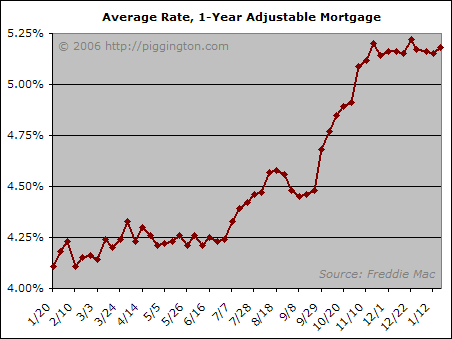This article contains a review of recent mortgage rate activity, lender tightening (or lack thereof), San Diego borrower behavior, and the current and potential effects of all of the above on the housing market. Also included are some thoughts on what "asset inflation" could mean to our economy.
January wasn’t the most eventful month in the credit markets. There wasn’t any major news, and the interest rate situation hasn’t changed substantially. Adjustable rates have been effectively flatlined since their autumn surge. Fixed rate mortgages, meanwhile, have continued to decline quite steadily since the fall runup:


The drop in fixed rates would lend some support to the housing market, if more people incurred fixed mortgages. However, despite the convergence between fixed and adjustable rates—the rate on a 30-year fixed mortgage is now just 92 basis points higher than that on a 1-year ARM—the large majority of San Diegans (77%, in recent months) still choose adjustable mortgages. That people would expose themselves to potentially much higher future payments just to get such a meager reduction in the initial rate is testament to San Diegans’ widespread willingness to take on risk. But while interesting (to me), that’s beside the point—the point is that it is still the ARM rate that is likely to move the market.
That rate has flattened out since mid-November, as is shown above. But it’s still substantially higher than it was a few months before that. Importantly, given the lag time between mortgage rates being locked in and home sales actually closing (and me getting the data on the closed sales), we may only now start to see the effects of the late-autumn ARM rate increase. I should get the latest batch of housing data within the next few days, so I ought to have more detail on current price action soon.
As far as what the future holds, I believe that despite the helpful decline in fixed rates, the high level of adjustable rates will continue to exert downward pressure on home prices. I don’t believe that the much-hoped-for springtime rally in the housing market will take place unless ARM rates drop—which is unlikely, considering that the Fed is for the time being still in tightening mode.
In the underwriting risk department, the recent OCC draft guidelines (discussed in last month’s Credit Market Report) do not appear to have had a lot of effect just yet. I’ve heard anecdotally that some lenders are tightening standards in general, but also that the more risky lenders are actually loosening their lending standards to gain market share. So at the moment the lender attitude towards risk seems to be a bit of a wash. Should lenders back away noticeably from further risk, whether due to further Fed tightening or to increased regulation, the housing market would certainly suffer as a result. But it hasn’t happened yet, and it may not for quite some time, so this factor remains a bit of a wild card for now.
Bonus Rambling: Asset Inflation
Since there wasn’t too terribly much to report on in the credit market this month, I thought I would spend a little time discussing the concept of "asset inflation."
Most people think of "inflation" as "a rise in the cost of goods and services," or something to that effect. But this definition really confuses cause and effect: inflation is more properly defined as an increase in the supply of money compared to the supply of stuff that money can buy. The commonly cited rise in costs is actually a symptom of inflation: too much money is chasing too few goods, and prices go up.
One can use this definition to view rising asset prices in a different light. An increase in the price of an asset class (stocks, bonds, real estate, etc.) is usually viewed as a "bull market." But it could also be considered a manifestation of inflation, whereby the increased pool of money is chasing assets instead of consumer goods. This, in a nutshell, is the idea that the phrase "asset inflation" intends to convey.
While most people consider rising asset prices to be an unabashedly good thing, there are some downsides. A recent Economist article notes:
Asset-price inflation can be as harmful as conventional inflation. A sudden collapse in share or house prices can trigger a deep downturn. And surging asset prices also distort price signals and cause a misallocation of resources—by encouraging too little saving, or too much investment in housing, so reducing future growth. This is why central banks need to pay closer attention to asset prices.
The second point, about misallocated resources, seems especially important. Instead of investing in productive capital (computers, software, factories, etc.) that will generate income in the future, we are spending all our money—and borrowing a whole lot more from foreigners—to build new non-income-producing McMansions. That the prices of said McMansions have risen seems irrelevant. Even if they do not fall (which is, for many parts of the country, an optimistic assumption), the fact is that we have reduced our competitiveness in the global economy by opting to spend precious little on our future means of production. This is largely an outcome of the boom in asset prices, and it isn’t really a good thing.
As a matter of fact, the more we outsource production by importing the stuff we need (food, fuel, clothing, etc.) and opt to spend our own time trading financial assets back and forth, the more likely it is that our currency will decline eventually, leading to an exchange rate-driven rise in those imported goods. Thus could asset price inflation lead to consumer price inflation, an outcome that would guarantee higher rates and generally be a bad thing all around.
This is a fairly deep topic but I thought it might be interesting to present a brief overview. Those who would like to learn more might consider the above-quoted Economist article, written a couple weeks ago, about the Fed’s stance on asset inflation.
